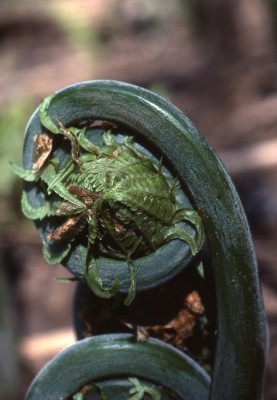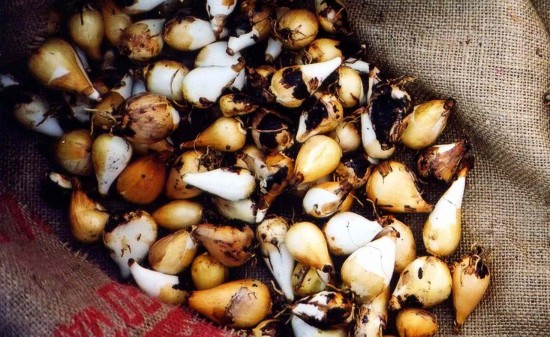Camas, an edible bulb traditionally eaten by the native people from Western Canada, and fiddleheads, the new fronds of the Ostrich fern plant resembling the scroll of a violin, have recently been accepted on the Canadian Ark of Taste as endangered foods to be protected and remembered.
Camas plants grow in soil-filled crevices of the rocky areas, and in moist prairies and hillsides in the spring in southwestern British Colombia and southwestern Alberta and parts of the northwestern United States. Until the 20th century, camas bulbs were an important part of the diet of indigenous peoples and the second most traded item, after salmon. Camas plants have grass-like leaves, with flowers varying from dark to light blue or occasionally white.
Camas bulbs should be cooked and immediately consumed or dried for winter use or trade. Steaming the bulbs is the most common method, usually for over 24 hours and up to 70. Bulbs can also be boiled and mashed into a thin paste or roasted. The cooked camas have a sweet taste, and a flavor described as similar to a baked pear, prune or sweet chestnut. Dried flattened bulbs would historically be served with seal, whale or fish oil. Cooked camas were commonly served at First Nations’ celebrations until only a few decades ago, when the tradition of cultivating, harvesting and cooking were almost lost completely, as the bulbs were replaced by potatoes and other introduced root vegetables. Today, camas bulbs are threatened by invasive species crowding growing grounds and are now classified as a rare species.
 Ostrich fern fiddleheads are found near floodplains or riverbanks in rich, alluvial soil, or in bottomlands thickets and woods. They have the form of a tightly cured green head with a thick stem that resembles the scroll of a violin, and a taste similar to asparagus, beet greens, artichoke or okra, with a grassy or herbaceous aroma. They are also high in potassium. The earliest people known to consume the plants were the Malecite and Mi’kmaq tribes of southeastern Canada. Colonialists and French Acadian settlers in North America also took to cooking the fiddleheads, often sautéed in animal fats, making soups or turning them into a tonic. Fiddleheads can be found at farmers’ markets and supermarkets in Canada, but their sale is considered a small industry.
Ostrich fern fiddleheads are found near floodplains or riverbanks in rich, alluvial soil, or in bottomlands thickets and woods. They have the form of a tightly cured green head with a thick stem that resembles the scroll of a violin, and a taste similar to asparagus, beet greens, artichoke or okra, with a grassy or herbaceous aroma. They are also high in potassium. The earliest people known to consume the plants were the Malecite and Mi’kmaq tribes of southeastern Canada. Colonialists and French Acadian settlers in North America also took to cooking the fiddleheads, often sautéed in animal fats, making soups or turning them into a tonic. Fiddleheads can be found at farmers’ markets and supermarkets in Canada, but their sale is considered a small industry.
Ostrich fern fiddleheads are mainly a foraged plant, and there is an unwritten code among foragers that sustainable harvests means taking no more than three fiddleheads per plant. A plant can produce only five to nine fronts per growing season. Today, the Saint John River Basin, a traditional growing site for wild fiddlehead ferns, has become increasingly polluted with heavy metals. It is possible that fiddleheads are reaching heavy metal toxicity levels and are becoming unsuitable for human consumption.
About the Ark of Taste
Slow Food Canada’s Ark of Taste reflects Canada’s vast, diverse landscape of peoples and foods. The Ark of Taste is an international catalog of foods that are threatened by industrial agriculture, the standardization and large-scale distribution of global food markets, and environmental degradation.
For more information:
Laura Buckley, chair of the Canadian Ark of Taste Commission
